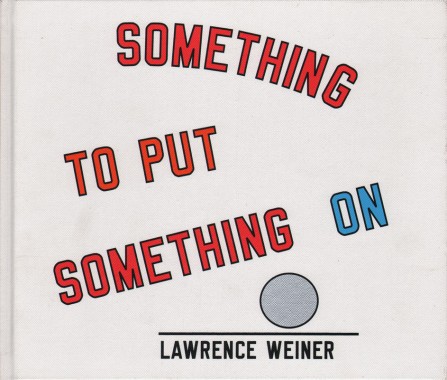
Lawrence Weiner, Something To Put Something On
Hardcover, 44 pp., offset 4/4, 255 x 215 mm
Edition of 5000
ISBN 9783865214911
Published by Steidl
$35.00 ·
Something to Put Something On poses direct questions about art-making to and for young readers. Generously endowed with its maker’s legendary wit, it is also, appropriately, the first title in the Little Steidl program. Neither storybook nor autobiography,
Something to Put Something On is rather a “questioning book” for children, at once moving and intriguing in its candor:
I WAS A CHILD & AS MOST CHILDREN I DID MAKE THINGS
I TRIED TO FIND A PLACE TO PUT THE THINGS I HAD MADE
AGAIN & AGAIN I FOUND THAT THE SUPPORT OR PLINTH OR TABLE
ALL RESTED UPON THE EARTH & I REALIZED THAT ALL PEOPLE OF ALL AGES
WHO HAD MADE SOMETHING HAD TO FIND A PLACE TO PUT
WHAT THEY HAD MADE
THOSE PEOPLE WHO ASK THE QUESTION & THOSE PEOPLE WHO TRY
TO ANSWER THE QUESTION ARE FUNCTIONING AS ARTISTS.
I WAS A CHILD & DECIDED TO BE AN ARTIST.
—Lawrence Weiner
Art, DAP, Education, Jerry Sohn, Lawrence Weiner, Margaret Seaworthy Gothic, Nina Holland, Simon Johnson, Steidl
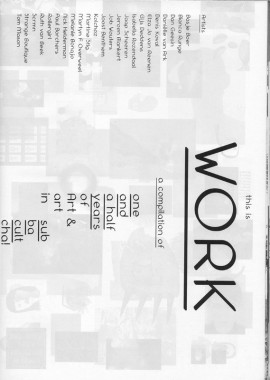
Bas Morsch, This is Work
Softcover, 10 posters/80 pp., offset 4/1, 210 x 297 mm
Edition of 1000
Published by Bas Morsch
$5.00 ·
A compilation of one and a half years of Art & art.
Art, Bas Morsch, Distribution, Isabella Rozendaal, Meinhard Spoor, Melanie Bonajo, Music, Nicole Martens
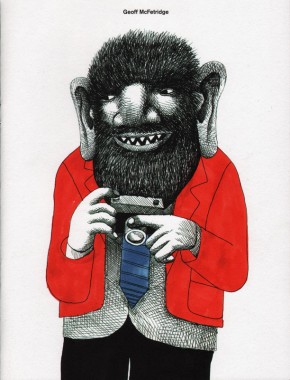
Geoff McFetridge, Recent Work
Softcover, 16 pp., offset 4/4, 195 x 255 mm
Edition of 1000
ISBN 978-3-905714-74-6
Published by Nieves
out of print
This book is a small collection of some of the work I have done for Spike Jonze’s film adaptation of the book Where the Wild Things Are.
Distribution, Geoff McFetridge, Nieves, Spike Jonze
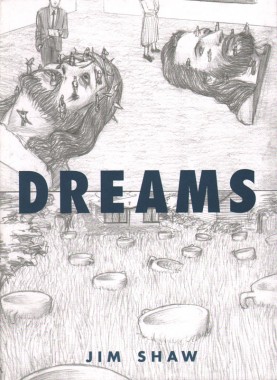
Jim Shaw, Dreams
Softcover, 288 pp., offset 1/1, 6 x 8 inches
Edition of 2000
ISBN 978-0-9646426-0-7
Published by Smart Art Press
$30.00 ·
Most people consider their dreams private property — too personal, too scary, and too weird to share — but not internationally renowned Los Angeles artist Jim Shaw. In Dreams, a monumental compendium of painstaking pencil drawings that bring his nocturnal dream world to life, the artist unflinchingly reveals his innermost fears, obsessions, and sexual fantasies. A diarylike picture book, Dreams is an in-depth look at one of the most important facets of this seminal artist’s work.
Jim Shaw, RAM, Smart Art Press
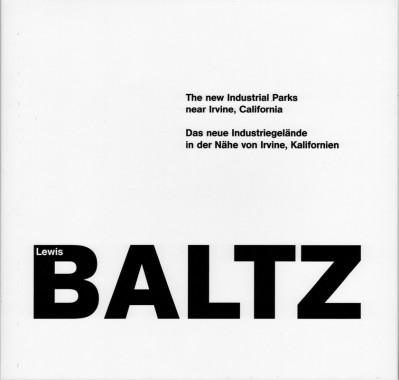
Lewis Baltz, The New Industrial Parks Near Irvine, California
Hardcover/slipcase, 112 pp., offset 1/duotone, 285 x 275 mm
English and German
Edition of 2000
ISBN 0-9630785-6-9
Published by RAM, Steidl
$55.00 ·
Lewis Baltz, with his iconic, minimalist photos of suburban landscape, is considered the founder of the New Topographics movement. Reproduced for the first time, his earliest portfolio, The Tract Houses (1971), and his preliminary forays into a minimal aesthetic, The Prototype Works (1967-1976), illuminate Baltz’s drive to capture the reality of a sprawling Western ecology gone wild. Together with The New Industrial Parks near Irvine, California, this trilogy reveals the indelible importance of Baltz in the development of contemporary photography. “Baltz turned his camera on the virtually featureless built environment of California … He pushed his compositions to an astringent minimum,” writes curator Sheryl Conkelton in an informative essay.
Art, Lewis Baltz, Photography, RAM, Sheryl Conkelton, Steidl, Whitney Museum
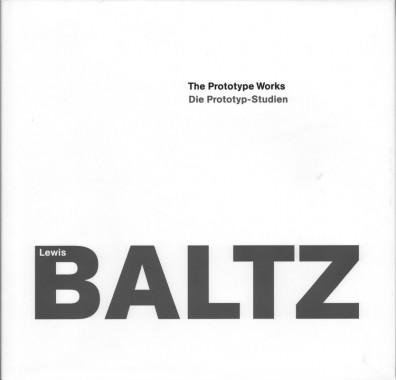
Lewis Baltz, The Prototype Works
Hardcover, 112 pp., offset 1/tritone, 285 x 275 mm
English and German
Edition of 2000
ISBN 0-9703860-5-2
Published by RAM, Steidl
$70.00 ·
Lewis Baltz, with his iconic, minimalist photos of suburban landscape, is considered the founder of the New Topographics movement. Reproduced for the first time, his earliest portfolio, The Tract Houses (1971), and his preliminary forays into a minimal aesthetic, The Prototype Works (1967-1976), illuminate Baltz’s drive to capture the reality of a sprawling Western ecology gone wild. Together with The New Industrial Parks near Irvine, California, this trilogy reveals the indelible importance of Baltz in the development of contemporary photography. “Baltz turned his camera on the virtually featureless built environment of California … He pushed his compositions to an astringent minimum,” writes curator Sheryl Conkelton in an informative essay.
Art, Lewis Baltz, Photography, RAM, Sheryl Conkelton, Steidl, Whitney Museum
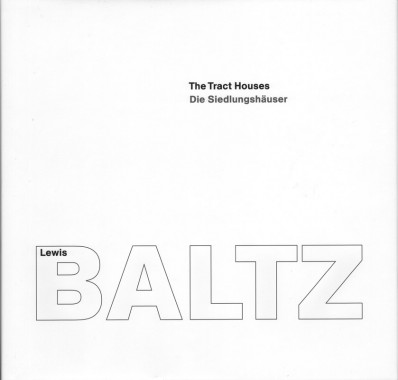
Lewis Baltz, The Tract Houses
Hardcover, 68 pp., offset 1/tritone, 285 x 275 mm
English and German
Edition of 2000
ISBN 0-9703860-4-4
Published by RAM, Steidl
$65.00 ·
Lewis Baltz, with his iconic, minimalist photos of suburban landscape, is considered the founder of the New Topographics movement. Reproduced for the first time, his earliest portfolio, The Tract Houses (1971), and his preliminary forays into a minimal aesthetic, The Prototype Works (1967-1976), illuminate Baltz’s drive to capture the reality of a sprawling Western ecology gone wild. Together with The New Industrial Parks near Irvine, California, this trilogy reveals the indelible importance of Baltz in the development of contemporary photography. “Baltz turned his camera on the virtually featureless built environment of California … He pushed his compositions to an astringent minimum,” writes curator Sheryl Conkelton in an informative essay.
Art, Lewis Baltz, Photography, RAM, Sheryl Conkelton, Steidl, Whitney Museum
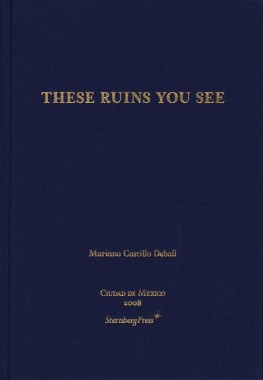
Mariana Castillo DeBall, These Ruins You See
Hardcover, 272 pp. + insert, offset 4/1, 155 x 225 mm
English and Spanish
Edition of 2000
ISBN 978-1-933128-46-7
Published by Sternberg Press
$30.00 · out of stock
An amazing book containing a collection of found objects and exhumed artifacts, contemporary and historical illustrations along with thought provoking essays, all looking at the changing ways Mexico has told the story of its past. The various layers of Mexico’s archaeology are forever present, giving rise to continual interpretations, reconstructions, demolitions, and annexations. This volume, based on a number of exhibitions, publications and lectures, brings together the history of collections and exhibitions of pre-Columbian objects, as well as the manufacture of replicas, the shadowy world of forgers and the relocation of key objects, among related themes. This eclectic grouping of ideas brings into sharp relief the ideological baggage and the range of museographic practices that always and inevitably frame our perception of these objects and artifacts.
Hannes Gloor, Manuel Raeder, Mariana Castillo Deball, RAM, Sternberg Press

Aleksandra Mir, Corporate Mentality
Softcover, 256 pp., offset 4/1, 230 x 300 mm
Edition of 2000
ISBN 0-9711193-1-7
Published by Sternberg Press
$40.00 ·
Calling for a reassessment of the function of art in late capitalist society,
Corporate Mentality focuses on the complex and ambiguous ways artistic production inhabits corporate processes, abandoning the autonomy of the artwork in order to elaborate resistant approaches to a world increasingly determined by commercial strategies and market concerns.
Based on an archive (1995–2001) maintained by Aleksandra Mir, it presents a diverse spectrum of artists who take on business as site, as material, and as subject of their work. As Will Bradley writes in frieze, “The book focuses on … an essential area of interest as artists wake up to the reality of the Clinton-era fantasy of ethical corporatism. The plan came out of Mir and Kelsey’s realization that the publicity industry wasn’t stealing artists’ ideas, but simply employing artists, like Mir herself, who needed a day job. ‘Radical’ aesthetics that had taken at least six months to travel (we’re in New York here) from downtown to uptown were now transferred almost instantaneously, causing artists to reassess their methods.”
Absolute Vodka, Anthony Davies, Art, Atelier van Lieshout, Bennett Simpson, Bernadette Corporation, Carey Young, Claude Closky, Daniel Pflumm, Dejanov & Heger, Gareth James, John Kelsey, Lars Bang Larsen, Laura K. Jones, Liam Gillick, Matthieu Laurette, Piotr Uklanski, Purple Institute, RAM, Simon Ford, Sternberg Press, Superflex, Will Bradley
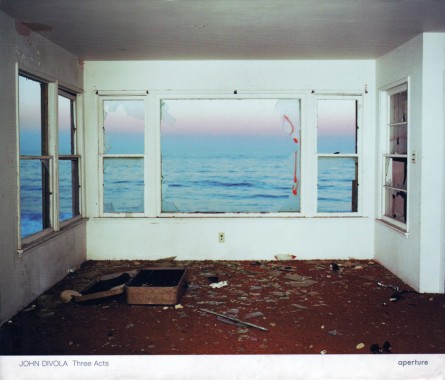
John Divola, Three Acts
Hardcover, 144 pp., offset 4/duotone, 11 x 9.25 inches
Edition of 2000
ISBN 9781931788953
Published by Aperture
$50.00 ·
In 1973, California artist John Divola began the first of three highly ambitious and original bodies of work that form Three Acts, the first book dedicated to them. His Vandalism series comprises black-and-white photographs of interiors of abandoned houses. Entering illegally, Divola spray-painted markings that referenced action painting as readily as the graffiti that was then becoming a cultural phenomenon. For the following year’s Los Angeles International Airport Noise Abatement series, he photographed a condemned neighborhood bought out to serve as a noise buffer for new runways, focusing on evidence of previous unsanctioned entries by other vandals. His final work, Zuma, documents the destruction of an abandoned beachfront property by the artist and others, as it deteriorates frame by frame and eventually burns. Divola has much in common with artists such as Bruce Nauman and Robert Smithson who have used photography to investigate other topics. He describes his innovative practice succinctly: “My acts, my painting, my photographing, my considering, are part of, not separate from, this process of evolution and change. My participation was not so much one of intellectual consideration as one of visceral involvement.”
Aperture, Art, DAP, David Campany, Francesca Richer, Jan Tumlir, John Divola, Michael Famighetti, Photography
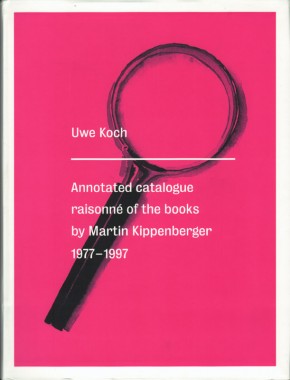
Martin Kippenberger, Annotated Catalogue Raisonné of the Books by Martin Kippenberger 1977-1997
Softcover, 368 pp., offset 1/1, 8.25 x 11 inches
Edition of 5000
ISBN 9781891024658
Published by Distributed Art Publishers
$55.00 ·
Roberta Smith called him the “madcap bad boy of contemporary German art” and also “one of the three or four best German artists of the postwar period.” Martin Kippenberger disrupted the status quo throughout his brief, excessive life, not just by making art of every variety and medium but also by conducting an extended performance in the vicinity of art that involved running galleries, organizing exhibitions, collecting the work of his contemporaries and overseeing assistants. He published books and catalogues, played in a rock-and-roll band and cut records, ran a performance-art space during his early years in Berlin, became part owner of a restaurant in Los Angeles during six months he spent there preparing for an exhibition, and collaborated extensively with other artists. This particular volume considers his output of artist’s books, as well as his exhibition catalogues and all the publications whose content he either created or edited. More than just documentation, this publication makes accessible for a wider public the multiple aspects of Kippenberger’s books, with all the complexity and consequence of his oeuvre intact.
Alex Katz, Art, DAP, Diedrich Diederichsen, Distributed Art Publishers, Martin Kippenberger, Roberto Ohrt, Typography, Uwe Koch
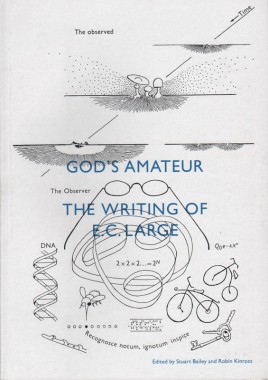
Stuart Bailey and Robin Kinross, God’s amateur: the writing of E.C. Large
Softcover, 96 pp., offset 3/1, 170 x 240 mm
Edition of 2000
ISBN 978-0-907259-38-1
Published by Hyphen Press
$20.00 ·
A book of and about E.C. Large, which contains a selection of his shorter writings — travel essays, reportage, reveries, reviews, critiques, autobiographical pieces — and which reveals the extent of his achievement. These show a notably exact writer, with sane no-nonsense views, and yet with great imagination. Some unpublished texts are shown in facsimile. Also here is a bibliography of his published writings (both ‘literary’ and scientific), and an essay by Stuart Bailey, which sees his work with present-day eyes.
Criticism, E.C. Large, Hyphen Press, PAP, Robin Kinross, Stuart Bailey
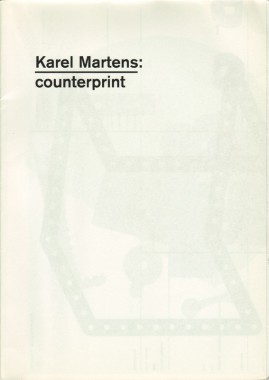
Karel Martens: Counterprint
Softcover, 32 pp., offset 4/4, 210 x 297 mm
Edition of 4000
ISBN 978-0-907259-25-1
Published by Hyphen Press
$35.00 ·
Throughout his career as a designer, Karel Martens has made artistic (uncommissioned) work. In his early days he used sheets of paper, cut to make reliefs. Then he began to make prints from Meccano, metal plates and washers, and other found objects. These prints were made in very small numbers, or were perhaps one-offs. They were studies in form and colour, done as experiments or intended as gifts to friends. The work was very much in the Dutch tradition of experimental printing (the artist H.N.Werkman is the great exemplar here). But Martens kept this work largely apart from his graphic design work. He has occasionally shown it in exhibitions, and some pieces were published in the book
Karel Martens: printed matter / drukwerk.
This is the first publication devoted to Martens’s prints. It is made in association with the printer Lecturis, in Eindhoven, and is produced to the highest quality. Bound in Chinese/Japanese fashion, like the first Martens book, it has a strong quality as an object. The main text in the book is an essay by the English designer Paul Elliman: ‘The world as a printing surface’. Dutch critic and teacher Carel Kuitenbrouwer provides a short introduction. The book is designed by Hans Gremmen, under the supervision of Karel Martens, at the Werkplaats Typografie in Arnhem.
Carel Kuitenbrouwer, Graphics, Hans Gremmen, Hyphen Press, Karel Martens, PAP, Paul Elliman, Typography, Werkplaats Typografie












